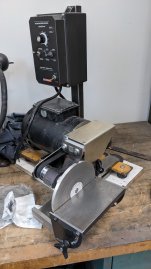The fingernail test checks sharpness, it doesn't tell you anything about edge quality. The serrations on the blade edge that caused the parallel groove patterns were too small for me to see with basic magnification, but on the scrape itself they are obvious. The lines can create a nice optical effect, but seem to be discouraged, again I suspect they can possibly increase the tendency for chatter. A fine diamond lap (1000-3000 grit) will smooth out that edge. The more uniform the edge, the stronger it will be so it should stay sharp longer as well.
View attachment 390924
If you look at (click to see full size) the factory scraping of this tiny Japanese plate you can see what I'm talking about with the parallel grooves. They are a very consistent pattern here, which looks better than the random patterns I was getting when I was first sharpening my blades without a honing step, but I think that's what people are pointing out. Again, I don't know if this is a real problem or an aesthetic choice, but chatter or blade life would be the two most obvious arguments against it.
Ahh, it wasn't clear what those were doing or how rigid that joint was. The measurement will obviously tell you what the stroke actually is. One thing about the Biax is that the main difference between the medium and heavy scrapers is the density of the metal used in the front castings. The tool weight is
absolutely a factor in the operation, and your tool has a very high reciprocating weight to mass ratio. So you may want to think about adding some ballast to the body (or as you seem pretty adept a counter balance is even more elegant.)





